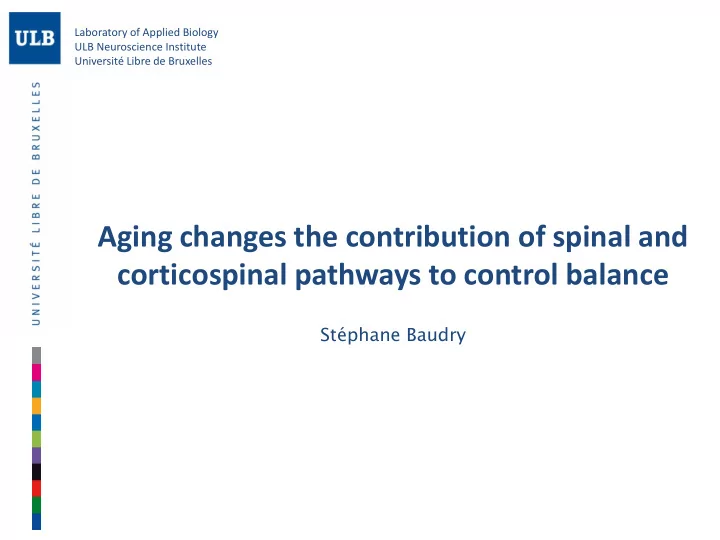

Laboratory of Applied Biology ULB Neuroscience Institute Université Libre de Bruxelles Aging changes the contribution of spinal and corticospinal pathways to control balance Stéphane Baudry
Gravity-driven instability of upright posture Abrahamova and Hlavacka, 2008
Neuromuscular components of upright standing: reflex standing? Decerebrate cat Brainstem transection (Sherrington 1910) CoM CoM
Neuromuscular components of upright standing: reflex standing? Decerebrate cat Brainstem transection (Sherrington 1910) Afferent Spinal network information Muscle activation Maintaining upright standing
Neuromuscular components of upright standing: supraspinal component? Ultrasound image Loram et al. 2004
Neuromuscular components of upright standing Defining Sensorimotor “Postural set” integration Supraspinal structures Afferent Spinal network information Muscle activation Maintaining upright standing
Spinal and corticospinal inputs onto soleus motoneurons Corticospinal pathway Soleus motor Muscle spindles neurons pathway Muscle activation Maintaining upright standing
Muscle spindles pathway Motoneurons Presynaptic terminals Motor axons Group Ia afferents (from muscle spindles) Hoffmann (H) reflex
Muscle spindles pathway M wave H reflex 2 mV 5 ms Intensity
Influence of age on H reflex during upright standing n = 142 Baudry 2016
Reflex gain Klass et al. 2011
Presynaptic origin for the greater H-reflex modulation in older? Baudry and Duchateau 2012
Presynaptic origin for the greater H-reflex modulation in older? Baudry and Duchateau 2012
Presynaptic origin for the greater H-reflex modulation in older? Ia Presynaptic inhibition PADs Ia afferents MNs Baudry and Duchateau 2012
Greater decrease in H reflex from seated to standing in older n=40 Baudry et al. 2015
Reduced synaptic inputs from group I afferents with age - Muscle spindles Soleus motor afferent inputs neuron pool -
Increased feedback latency Young Middle-aged Older H reflex Latency Increase in time-delayed feedback Reduction in synchronisation of synaptic inputs Scaglioni et al. 2003
Decreased reflex mechanical output Young Older Torque output Rate of torque development Scaglioni et al. 2003
Decreased relevance of muscle spindles afferents in upright standing - Muscle spindles Soleus motor afferent inputs neuron pool Mechanical output latency
Corticospinal pathway Transcranial magnetic stimulation - TMS + Corticospinal cells TMS + - + Cortico-cortical cells Spinal cord + Interneurones + - + Motorneurones MEP
Corticospinal pathway Transcranial magnetic stimulation - TMS MEP
Influence of age on H reflex during upright standing n = 94 Baudry 2016
Influence of age on MEP during upright standing Baudry 2016
Increased contribution of corticospinal inputs - Corticospinal Muscle spindles Soleus motor + afferent inputs inputs neuron pool Mechanical output latency
Increased in plantar flexor activity during upright standing Billot et al. 2010 Vandervoort and McComas, 1986
Increased in muscle activation aEMG (% MVC) Baudry et al. 2012 Billot et al. 2010
Increased corticomotoneuronal excitability Corticospinal cells MN Interneuron Corticomotoneuronal pathway MEP
Increased corticomotoneuronal excitability Baudry et al. 2014 MEP
Influence of muscle activation of H reflex Increase in muscle activity may alter proprioceptive signal Proske and Gandevia 2012 n = 94 Baudry 2016
Increase in muscle activation is associated with increased corticomotoneuronal drive and reduced relevance of group I afferents Muscle activity force - - Muscle spindles Corticospinal Soleus motor + + afferent inputs inputs neuron pool Mechanical output latency
Increased coactivation Coactivation index (%) Nagai et al. 2011 Coactivation index: EMG-TA/EMG-SOL combining high reflex gain (large H-reflex amplitude) and coactivation has an undesired effect on the steadiness of the motor output Dideriksen et al. 2015 Greater coactivation in older adults likely reduces the relevance of muscle afferent inputs
Ageing changes the contribution of spinal and corticospinal pathway to control balance coactivation Muscle activity force - - Corticospinal Muscle spindles Soleus motor + + afferent inputs inputs neuron pool Mechanical output latency
Training can modify age-related changes Penzer et al. 2015
Ageing changes the contribution of spinal and corticospinal pathway to control balance coactivation Muscle activity force - - Corticospinal Muscle spindles Soleus motor + + afferent inputs inputs neuron pool Mechanical output Those changes can likely be minimized by training latency
Recommend
More recommend